by By Michael Arny and Mary Reames
Leonardo Academy, Madison WI — The Leadership in Energy and Environmental Design (LEED) rating system for green buildings has been out in the marketplace since the year 2000. At the age of 14, LEED has matured from a bold new idea to a major component of the new- and existing-building marketplace.
The first rating system, LEED for New Construction (LEED-NC), was launched in 2000. LEED-NC was followed by LEED for Existing Buildings (LEED-EB) (2004) and LEED for Commercial Interiors (LEED-CI) (2005). Since then, a whole family of LEED rating systems has been developed that address more specific building types and building situations. LEED has also expanded its geographic reach from its launch in the USA to its current status as an internationally applicable rating system. And with the introduction of LEED v4, LEED continues to push the envelope of sustainable building, with more demanding thresholds and criteria.
The data on LEED registrations and certifications below were provided by the USGBC in January 2015.
With all this growth and expansion, it is interesting to step back and look at the achievements and trends in LEED certifications. We will start with a broad view of all the rating systems and then focus in on the three rating system juggernauts: LEED-NC, LEED-EB, and LEED-CI.
- LEED-NC: LEED for New Construction
- LEED-CI: LEED for Commercial Interiors
- LEED-EBOM: LEED for Existing Buildings, Operations & Maintenance
- LEED-CS: LEED for Core & Shell
Between 2000 and 2014, under all LEED rating systems, there have been 24,393 total LEED certifications, encompassing 3,456,921,433 gross square feet of certified floor area. Table 1 shows the number of certifications for each rating system. LEED-NC, LEED-EB, and LEED-CI are the front runners. Table 2 shows the floor area certified under each rating system. LEED-NC, LEED-EB, and LEED-CI are the leaders in this category as well. Note that more floor area has been certified under LEED-EB than under any other rating system, including LEED-NC.
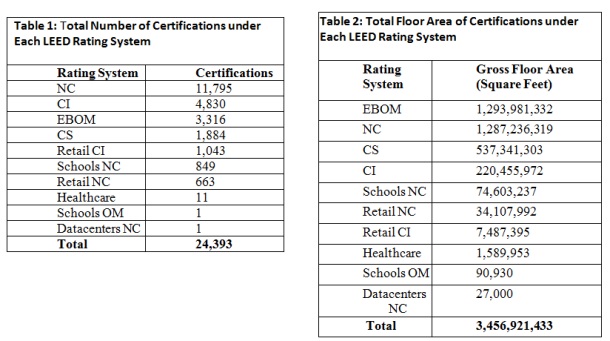
LEED Overall Certifications and Registrations
Figures 1 and Figure 2 show that LEED total registrations and certifications are both growing at an increasingly rapid pace.

Certifications under the Three Most Used LEED Rating Systems
Figures 3, 4 and 5 show the usage trends for LEED-NC, LEED-EBOM, and LEED-CI. Certifications under all three rating systems are growing at a good clip.
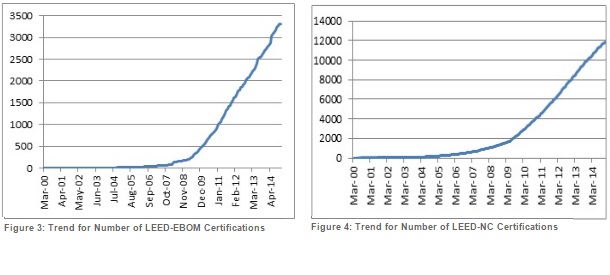
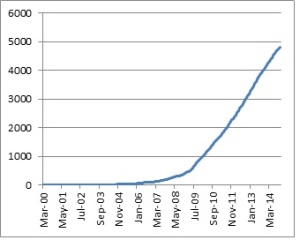
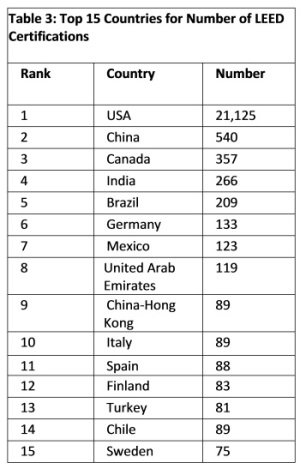
International Availability of LEED
How LEED has been available internationally has evolved over time. Initially, there was one version of LEED, which was developed for use in the USA; it did not allow for adjustments to fit the situations in other countries. Subsequently, country-specific versions of LEED were developed for several countries, including Canada, India, and Italy. Over time, the development of Alternative Compliance Paths (ACPs) and Regional Priority Credits (RPCs) made LEED applicable worldwide.
Based on this experience, LEED v4 has integrated ACPs and RPCs that make LEED adaptable to other countries. The earlier country-specific versions of LEED are being eliminated.
International Use of LEED is Growing Rapidly
More that 44% of the current LEED certifications now underway are for buildings located outside of the Table 3 shows the 15 countries that have the most LEED certifications, and Figure 6 shows the total numbers of LEED certifications in the U.S. and abroad.
What does This All Mean for You?
The use of all of the LEED rating systems in the U.S. and worldwide is growing rapidly. Reducing the environmental impact of buildings has gone from being a novel concept in building construction and management to being standard practice. As the use of LEED v4 grows, the next generation of LEED certified buildings will continue to have a decreased impact on the environment. Worldwide use of the LEED rating system will continue to expand due to the availability of locally applicable ACPs and RPCs.
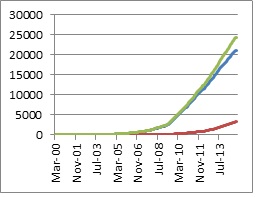
(Total = Green, US = Blue, and International = Red)
These trends indicate that green building design and operation is becoming more prevalent in the real estate marketplace. We often hear that tenants are specifically seeking out LEED certified buildings. In the near future, we see LEED certification being considered a must-have in the marketplace. If you haven’t considered pursuing LEED-EBOM certification for your existing building or LEED-NC or LEED-CI certification for your next building project, you could soon find yourself at a marketplace disadvantage.